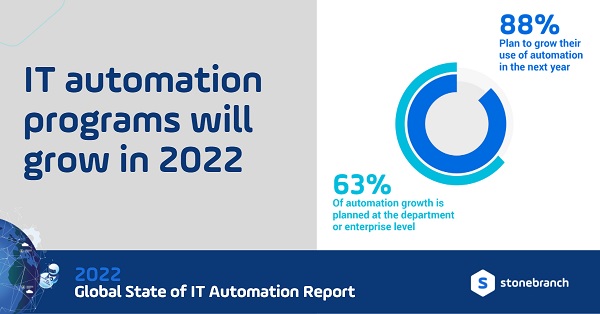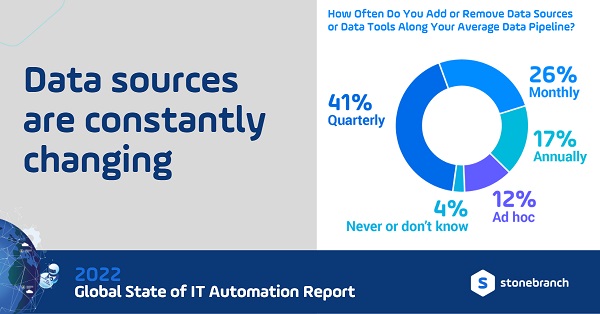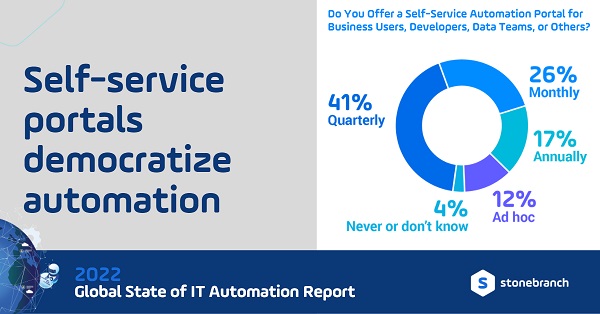The 2022 Global State of IT Automation report, co-created by Stonebranch and IEEE Computer Society, highlights the latest research, trends, and benchmarks to help organizations excel in automation and orchestration. Based on a survey of automation-focused IT professionals worldwide, the report offers a unique perspective on the convergence of automation with cloud, DataOps, DevOps, and hybrid IT topics. Read on to learn about the key findings.
Automation Programs Are Growing and Evolving Due to Multi-Cloud and Hybrid IT Environments
According to the study, nearly half (46%) of all mid-size and large enterprise organizations operate in hybrid IT environments that include on-premises, cloud (public and private), and containerized microservices. In addition, approximately 90% report using multiple public and private clouds.
To overcome the new layer of cloud complexity, organizations are rethinking how they orchestrate workflows and data transfers across systems located in on-premises and cloud environments — 88% plan to grow their automation program over the next 12 months. Much of this growth is an evolution from on-premises automation to hybrid IT orchestration: 43% of enterprises will invest in a service orchestration and automation platform (SOAP) by the end of 2022, only two years after Gartner coined the SOAP category in 2020.

Successful Data Pipelines Require Integration and Orchestration
The hybrid model is a key requirement in data pipelines as well. While 90% of enterprises have more than half their data pipeline tools in the cloud, 73% rely on on-premises data management tools. Data sources and tools are changing frequently, too. 78% report adding and removing data sources and tools from their pipeline at least quarterly, if not more often. The agile nature of data pipelines is enabled by the cloud; the need for pipelines to extend beyond a single hosting environment is driving this need for more sophisticated orchestration.
Integrations are critical to navigating the current state of flux in the data environments, sources, and tools. As a result, the ease by which an enterprise can connect their automation and orchestration platform with constantly changing third-party applications and data storage tools has become a critical aspect of new vendor/platform selection.
The big takeaway is that data architects and engineers are eager to achieve true data pipeline orchestration that centralizes the design and management of automated processes existing in multiple tools.

IT Automation Responsibilities Extend Well Beyond the Central IT Team
The guidance and leadership of a centralized IT automation team cannot be understated. 93% of enterprises report having a centralized IT automation team, even as adoption of federated (or center of excellence) models has grown to 36%. Though it might seem counter-intuitive, the survey indicates that as central automation teams get bigger, they’re more likely to adopt a federated IT model.
Why is this?
Larger central teams help democratize IT automation and enable citizen automators by defining standards, implementing reusable automation components, and promoting best practices. This eliminates tribal knowledge and drives people to use a core set of tools. 84% of organizations offer a self-service automation portal to users across the business.
The democratization of IT is especially evident in cloud operations, where 91% of respondents reported responsibility for at least some cloud operations, even though only 9% identified CloudOps as their full-time role… and 88% reported having a centralized CloudOps team.

From Task Automation to Centralized Orchestration
With cloud adoption increasing and driving a much more complex IT landscape, traditionally siloed task automation has begun to evolve into centralized orchestration. Enterprise teams that span all departments — from IT Ops to data, development, and business groups — have a growing thirst for automation as a service. Offered by centralized IT automation teams, this service helps connect workflows that span on-premises, clouds, and containers within hybrid IT environments.


